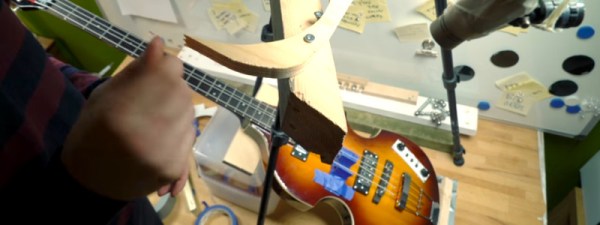Stringed instruments make noise from the vibrations of tuned strings, using acoustic or electronic means to amplify those vibrations to the point where they’re loud enough to hear. The strings are triggered in a variety of ways – piano strings are hit with hammers, guitar strings are plucked, while violin strings are bowed. Meanwhile, [Martin] from the band [Wintergatan] is using marbles to play a bass guitar.
[Martin] starts out with a basic setup. The bass guitar is placed on the workbench, while a piece of wood is taped to a tripod. The wood has a hole drilled through it, and marbles are dropped through the aperture in an attempt to get them to land on the string. Plastic containers are used to easily alter the angle the bass guitar sits at, relative to the bench, while an acrylic guide sits around the string to try to guide the marbles in the desired direction. These guides are important to make sure the marbles hit the top of the string, and bounce cleanly in the desired direction afterwards.
The initial setup is too inconsistent, so [Martin] places a notch in the wood and builds a lever system to hold the marbles and then release them in a controlled manner. [Martin] then checks that the system works by analysing footage of the marble drop with slow motion video.
The video covers the CAD design of an eight-slot guide so the four strings of the bass can be played more rapidly than in their previous build. Two guides per string allow each string to play two notes in quick succession without having to worry about marble collisions from playing too quickly.
It’s a great build, and we’ve seen [Wintergatan]’s work before – namely, the incredible build that was the original Marble Machine.
Thanks to [Tim Trzepacz] for the tip!












